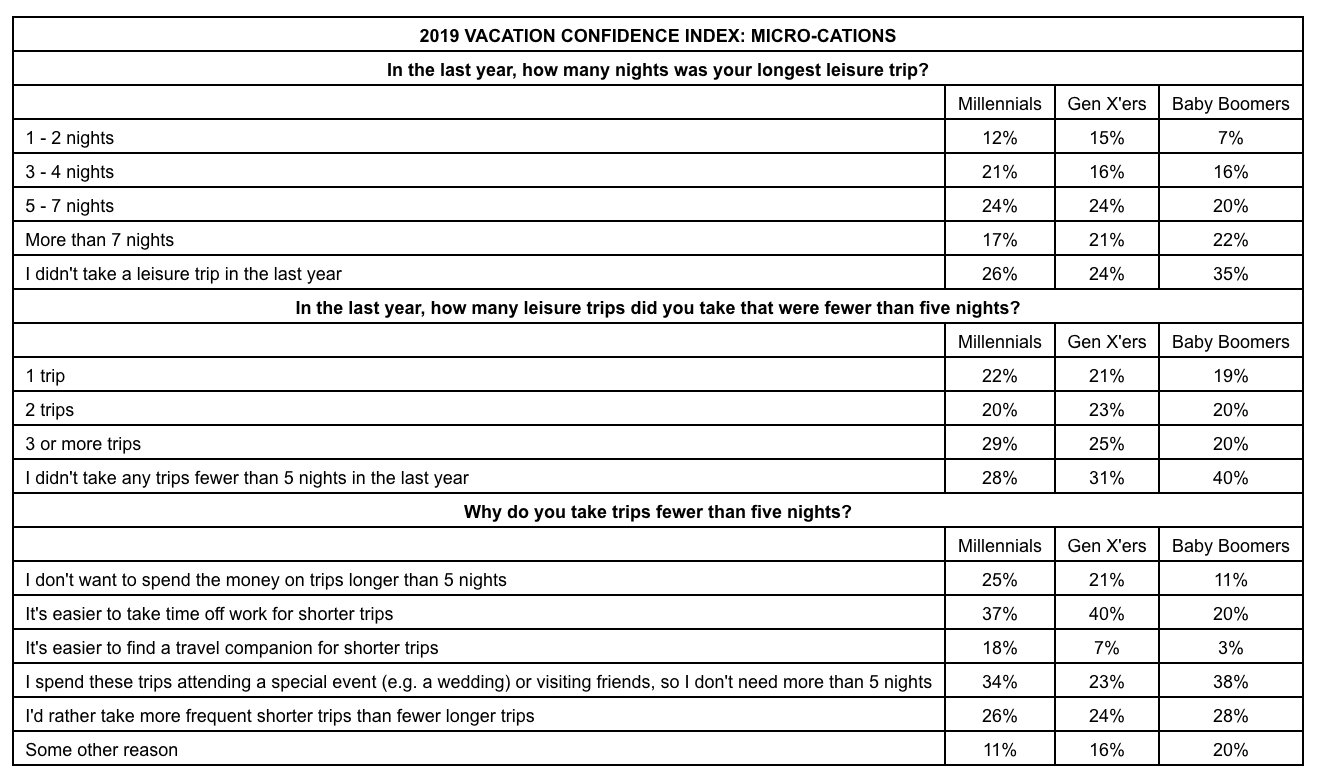Millennials Opt for “Micro-cations”
The majority (57%) of Americans did not take a leisure trip longer than four nights in the last year, with Millennials leading this “micro-cation” trend, according to the 2019 Vacation Confidence Index* released by Allianz Global Assistance. A “micro-cation” is defined as a leisure trip that is fewer than five nights.
Nearly three-fourths (72%) of Millennials took at least one micro-cation in the last year, while 69% of Gen X’ers and 60% of Baby Boomers did the same.
Not only are Americans taking shorter trips, but for many, these micro-cations are replacing the traditional week-long vacation. Almost two in ten Americans (18%) said their longest trip in the last year was three to four nights, while one in 10 (11%) took no trips longer than just one to two nights.
Micro-cations may allow Americans to travel more frequently, with 25% of the general population and one in three (29%) of Millennials saying they took at least three micro-cations in the last year.
More seasoned generations still prefer longer trips, with 40% of Baby Boomers surveyed avoiding trips fewer than five nights in the last year, compared to 34% of the general population. Millennials are less likely than their older counterparts to take longer trips: only 17% of Millennials took a trip longer than seven days in the last year, compared to 21% of Gen X’ers and 22% of Baby Boomers. On the flipside, 12% of Millennials and 15% of Gen X’ers said their longest trip was just one to two nights, compared to 7% of Baby Boomers.
While the short vacations trend may be on the rise, this year’s survey also found that over one-quarter (28%) of all Americans have not taken a leisure trip of any length in the past year. Baby Boomers are especially guilty, with 35% saying they did not take a leisure trip in the last year. A quarter of their younger counterparts (26% of millennials and 24% of Gen X) said the same.
When asked why they prefer to take micro-cations, 32% of Americans said it was easier to take time off work for shorter periods, and another 32% said they did not need more than five nights for the purpose of the trip, like attending a wedding or visiting friends. Other reasons include: preferring to take more frequent shorter trips than fewer longer trips (26%); not wanting to spend money on longer trips (19%); and it being easier to find a travel companion for a shorter trip (10%).
The generational differences between responses demonstrate the varied reasons micro-cations appeal to different populations. For instance, one-quarter of Millennials say money is a primary reason to take shorter trips, which supports other findings that those with a higher income are more likely to vacation longer. More than half (51%) of people making $50,000 or more took trips longer than 5 nights in the last year, compared to 29% of those who make less than $50,000.
Taking less time off work was most important to Gen X’ers (40%), followed closely by Millennials (37%) and then working Baby Boomers (20%). Millennials (34%) and Baby Boomers (38 percent) take trips to attend special events or family occasions at much higher rates than Gen X’ers (23%), while finding a travel companion is more of a concern to Millennials (18%) than Gen X’ers (7%) and Baby Boomers (3%).
“The days of the ubiquitous week-long summer vacation may be disappearing, but we’re happy to see that Americans, especially Millennials, are eager to travel more frequently. The rise of micro-cations may also lead to increased interest in visiting vibrant domestic locales over exotic, far-flung destinations. Whether traveling for two nights or two weeks, travel insurance can protect you, your luggage and your vacation investment.” – Director of Communications at Allianz Global Assistance USA, Daniel Durazo.

*Methodology: These are findings of an Ipsos poll conducted on behalf of Allianz Global Assistance. For this survey, a sample of 1,005 Americans from the Ipsos I-Say panel was interviewed from May 1st to May 2nd, 2019. The precision of online polls is measured using a credibility interval. In this case, the results are accurate to within +/- 3.5 percentage points, 19 times out of 20, of what the results would have been had all American adults been polled. Quota sampling and weighting were employed in order to balance demographics and ensure that the sample’s composition reflects that of the actual U.S. population, according to data from the U.S. Census Bureau. Credibility intervals are wider among subsets of the population. For the purposes of this study, a Millennial is defined as someone between the ages of 18 and 34; a Gen X’er is between the ages of 35 and 54; and a Baby Boomer is 55+ years of age.



